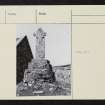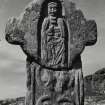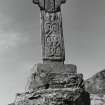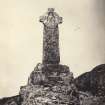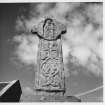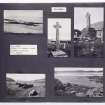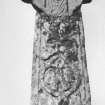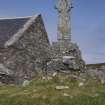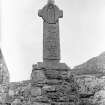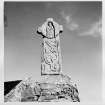Oronsay, Small Cross
Cross(S) (Medieval)
Site Name Oronsay, Small Cross
Classification Cross(S) (Medieval)
Canmore ID 233007
Site Number NR38NW 10
NGR NR 34987 88943
Datum OSGB36 - NGR
Permalink http://canmore.org.uk/site/233007
- Council Argyll And Bute
- Parish Colonsay And Oronsay
- Former Region Strathclyde
- Former District Argyll And Bute
- Former County Argyll
External Reference (20 July 1971)
c. 1350 (?). Disc-type. Carving of Virgin on disc stepped
base.
Argyll C.C. 'List'
Stuart 'Sculptured stones of Scotland' Vo. II, p. 32 (ill.)
Grieve 'Colonsay and Oronsay, Vol. I, p. 574.
Situated to E. of Priors House. Broken in 19th century
and re-assembled c. 1910.
Information from Historic Scotland, 20 July 1971
Field Visit (June 1977)
(31) Lower part of the shaft of a free-standing cross, which at some time before 1870 was joined to the head of another cross (number 35) and set on a circular base of mortared rubble-masonry. The fragment measures 0.79 m in height and 0.32 m in width by 0·08 m in thickness above a tenoned butt; the top few centimetres of surface-ornament shown in Stuart's drawing were cut back to facilitate the attachment of the new cross-head. It is carved on one face only with a double roll-moulding enclosing two intertwined plant-stems. (SSS, 2, pl. lxiii; Loder, Colonsay, pl. xxxi a; Steer and Bannerman, Monumental Sculpture, pl. 28A). Iona school, 14th-15th century.
(35) Head of a free-standing cross, now joined to the cross-shaft number 31. The diameter of the disc is 0·34 m and the maximum span 0·46 m. The back is undecorated, and the front is dressed smooth except for traces of an incised marginal groove and a central round-headed cusped niche containing a bearded figure in low relief. He wears a voluminous robe which swirls across the lower part of his body, and the right hand is raised in blessing above a chalice, held in the other hand, from which a small creature emerges. This identifies the figure as St John the Evangelist, who was believed to have expelled venom in the shape of a dragon, from a poisoned chalice. (Steer and Bannerman, Monumental Sculpture. pl. 28A; SSS. 2, pl. lxiii; Loder, Colonsay. pl. xxxi a). Probably Oronsay school. c.1500- 1560.
RCAHMS 1984, visited June 1977


















